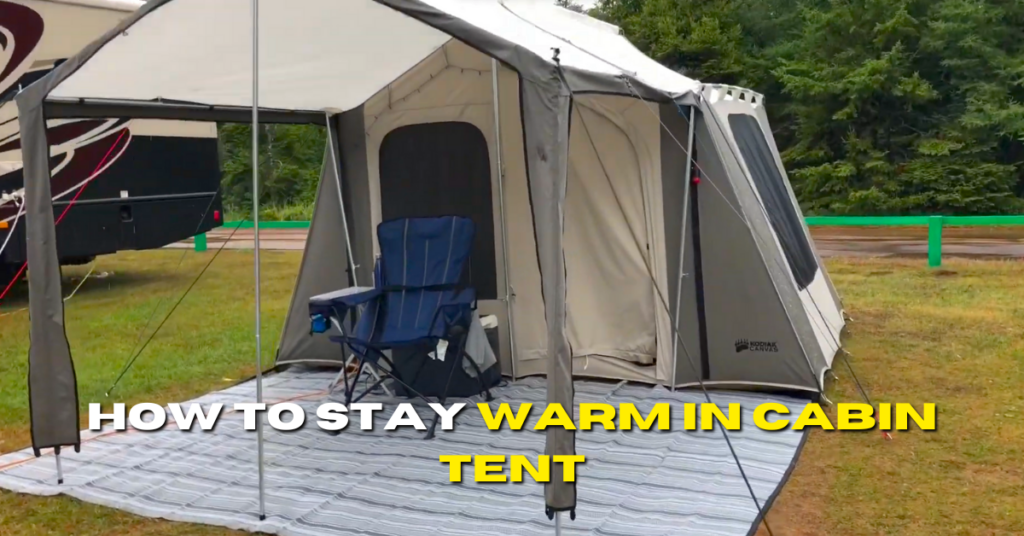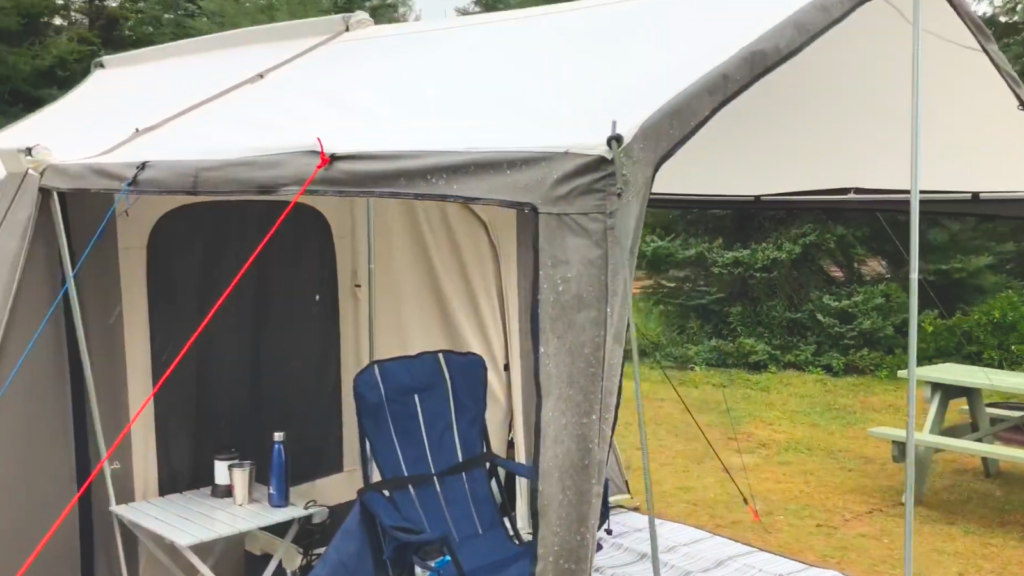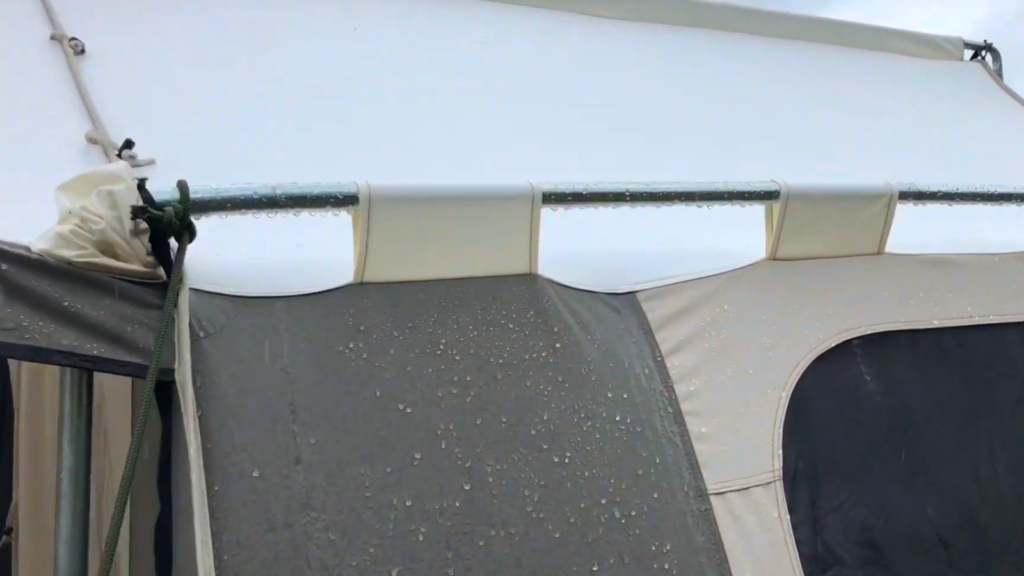
Mastering the art of ‘How To Stay Warm In A Cabin Tent’ is essential for any outdoor enthusiast looking to enjoy nature.
This guide presents practical strategies encompassing heat loss understanding, appropriate gear selection, and more. Let’s dive into these warmth-preserving techniques for a cozy cabin tent camping experience.
Table of Contents
Understanding The Basics Of Heat Loss In a Cabin Tent

When you’re staying in a cabin tent, staying warm is critical. There are four basic methods of heat loss: conduction, convection, radiation, respiration, and perspiration. Understanding these and how to counteract them can help you stay warmer.
Conduction
Conduction is the process through which heat is lost through direct contact. For example, if you’re lying on cold ground in a tent, your body heat can be conducted away from you and into the ground.
To minimize conduction-based heat loss, use a ground cloth or a tent footprint underneath your tent. This will help insulate the tent from the cold ground. Additionally, consider investing in an insulated sleeping pad. These are designed to provide a barrier between you and the cold ground, helping to reduce the amount of heat that is carried away from your body.
Convection
Convection refers to the loss of heat through air movement. When cold air circulates around your body, it can draw away heat and make you feel colder.
Combat convective heat loss by using wind barriers such as trees, rocks, or even your car. The positioning of your tent can also have an impact. If possible, set up your tent with the door facing away from the prevailing winds. This can help to reduce the amount of cold air that enters your tent.
Radiation
Radiation is the process of losing heat to the environment around you. Just as a radiator emits heat into a room, your body radiates heat into the air and ground around you.
To help retain some of this radiant heat, consider using a space blanket or reflective tarp. These can be used inside the tent to reflect some of the radiated heat back toward you, helping you to stay warmer.
Respiration and Perspiration
Lastly, your body’s own processes can contribute to heat loss. As you breathe, you expel warm, moist air, which can lead to heat loss. Additionally, if you sweat, the evaporation of that sweat can cool your body.
To stay warm, aim to control respiration and perspiration. Dressing in layers can help with this; you can add or remove layers as needed to maintain a comfortable temperature and minimize sweating. Hydrating properly is also essential, as dehydration can make you feel colder.
Selecting The Right Gear
Ensuring you have the appropriate gear is crucial for staying warm in a cabin tent. This includes the tent itself, your sleeping gear, and your clothing.
Appropriate Tent Selection
The tent you choose can play a significant role in how warm you stay. Insulated tents, for example, come with an extra layer of fabric that provides insulation and can help to keep you warm. Non-insulated tents may require additional measures to maintain warmth.
A rainfly or tent roof is also essential for heat conservation. Not only does it provide protection from the elements, but it also helps to trap warm air inside the tent.
Choosing The Right Sleeping Gear
Your sleeping gear can significantly impact your comfort and warmth. Look for a high-quality, cold-rated sleeping bag that is appropriate for the temperatures you expect to encounter. These are designed with special materials and construction to trap heat and keep you warm.
Consider adding a sleeping bag liner for extra warmth. These liners can add a significant number of degrees to the bag’s temperature rating, providing an extra buffer against the cold.
Heated sleeping pads are another great option. They provide a source of heat directly beneath you and help to insulate against the cold ground.
Layered Clothing
Layered clothing is one of the most effective ways to stay warm in cold weather. The idea is to trap warm air close to your body while protecting against cold air and wind.
Typically, you should have three layers: a base layer to wick moisture away from your skin, a middle layer for insulation, and an outer layer to protect against wind and rain. Material choice is key here. For the base layer, consider materials like merino wool or synthetic fabrics that wick moisture well. For the middle layer, fleece or down are good options. The outer layer should be water-resistant and breathable.
Keep in mind that conditions can change quickly, so it’s important to be able to adjust your layers as needed. This means you should be able to easily add or remove layers to adapt to changing temperatures and weather conditions.
Tent Heating Options
Even with the right tent, sleeping gear, and clothing, sometimes you may need additional heat sources to stay warm in a cabin tent. These can range from portable heaters to heat packs and heated blankets.
Portable Heater Safety
Portable heaters can be a good source of heat in a tent, but safety is paramount. There are several types of heaters that can be used, including propane, electric, and battery-powered heaters.
Propane heaters produce a lot of heat and are generally reliable. However, they can also produce carbon monoxide, a deadly gas, so you must ensure your tent is well-ventilated. Electric heaters are safer in this respect, but they require a power source. Battery-powered heaters are convenient and safe but may not produce as much heat.
When using a heater in a tent, ensure it is placed on a stable surface and away from any flammable materials. Never leave a heater unattended in a tent and make sure it is switched off before you go to sleep.
Heat Packs and Heated Blankets
Heat packs and heated blankets can also provide additional warmth. Heat packs can be activated and placed inside your sleeping bag to provide heat for several hours. Heated blankets often run on battery power and can be used to warm up your sleeping space before you get into bed.
Always follow the manufacturer’s instructions when using these products. While they are generally safe, it’s important not to overheat them or place them directly against your skin for prolonged periods. Additionally, heated blankets should not be left on while you sleep due to the risk of overheating or fire. It’s best to use these to warm up your sleeping bag before you get in, then turn them off and rely on your sleeping bag and layers for warmth.
Campsite Selection and Tent Positioning

The location of your campsite and the positioning of your tent can have a significant impact on your comfort and warmth.
Choosing a sheltered campsite can help to minimize your exposure to wind and cold temperatures. Look for natural windbreaks, such as trees or hills, which can help to protect your campsite. Avoid valleys and low-lying areas where cold air can accumulate, and instead aim for flat terrain.
The position of your tent relative to wind and sunlight is also crucial. If possible, orient your tent so that the smallest side faces the wind, reducing the surface area that is exposed. Additionally, positioning your tent to capture the morning sun can help warm it up faster, making those chilly mornings more bearable.
Food and Hydration
Consuming the right food and staying properly hydrated can also help keep you warm.
When your body metabolizes food, it generates heat in a process known as thermogenesis. Foods that take longer to digest, such as fats and proteins, can help keep your internal furnace burning longer. Consider high-energy camp foods like nuts, dried fruits, cheese, and high-calorie granola bars.
Hot drinks can provide immediate warmth and help keep you hydrated. Drinking plenty of water is also important, as dehydration can make you more susceptible to the cold. Be sure to drink regularly, even if you don’t feel thirsty. A hot cup of tea, coffee, or even just warm water can make a significant difference in your body temperature and overall comfort.
Remember, the key to staying warm in a cabin tent is planning and preparedness. Understand the basics of heat loss, choose the right gear, consider additional heat sources, pick your campsite wisely, and pay attention to your food and hydration. These steps can help ensure a warm and enjoyable camping experience.
Conclusion
Staying warm in a cabin tent involves a combination of understanding heat loss mechanisms, selecting the right gear, using appropriate heat sources, choosing your campsite strategically, and maintaining optimal food and hydration levels. Each of these elements plays a vital role in ensuring you stay comfortable, safe, and warm during your camping experience. With a little preparation and the right knowledge, you can turn a potentially chilly camping trip into an enjoyable adventure in the great outdoors, regardless of the temperature outside. Enjoy the unique, restful experience of cabin tent camping, even when the weather turns cold.
What To Do Next
Now that you’re well-equipped with knowledge on staying warm in a cabin tent, you’re all set for your next camping adventure. But wait, there’s more to explore! Different types of cabin tents have unique features that cater to varying camping needs and weather conditions. Each offers a unique blend of comfort, portability, and durability.
Perhaps you’re curious about these diverse tent styles and wish to delve deeper. Understanding the types of cabin tents will allow you to make a more informed decision on the best one for your specific needs, enhancing your camping experience even further. So why not continue your journey into the exciting world of cabin tent camping? You might be surprised at what you’ll discover next!
Frequently Asked Questions
What’s the best way to keep a cabin tent warm?
Keeping a cabin tent warm involves understanding heat loss mechanisms such as conduction, convection, radiation, respiration, and perspiration, and counteracting them. This can be done by using insulated sleeping gear, positioning the tent strategically to minimize wind exposure, using heat sources like portable heaters or heat packs, and dressing in layers. Consuming high-energy foods and staying hydrated can also help keep you warm.
How does dressing in layers help in staying warm in a cabin tent?
Dressing in layers works on the principle of trapping warm air close to your body while also allowing flexibility to add or remove layers as the temperature changes. Typically, a three-layer system is used, which includes a base layer for moisture wicking, a middle layer for insulation, and an outer layer for wind and rain protection.
What types of heaters are safe for use in a cabin tent?
Portable heaters like propane, electric, and battery-powered heaters can be used in a cabin tent. Each has its pros and cons. Propane heaters produce a lot of heat, but they can also produce carbon monoxide, so adequate ventilation is essential. Electric heaters are safer in this regard but require a power source. Battery-powered heaters are convenient and safe but might not produce as much heat.
How do food and hydration help in keeping warm in a cabin tent?
When your body metabolizes food, it generates heat, a process known as thermogenesis. Foods high in fats and proteins that take longer to digest can help keep you warm. Staying hydrated is also crucial, as dehydration can make you more susceptible to the cold. Hot drinks can provide immediate warmth and help keep you hydrated.
Why Should You Trust The Adventure Vine?
I’m Mukarim Zargar, a lifelong lover of the great outdoors. My passion for camping and adventure was ignited at the tender age of 7, and it’s a flame that has only grown brighter with time.
Over the years, I’ve pitched tents under starlit skies, hiked through verdant forests, and navigated winding trails. Each adventure has been a lesson, each challenge a teacher. This wealth of experience has equipped me with a deep understanding of the outdoors, from the essential gear needed for a successful camping trip to the best techniques for wilderness survival.
But my journey is far from over. I continue to explore, camp, and immerse myself in the beauty of nature. And now, I want to share my knowledge and experiences with you. Through this website, I aim to inspire, guide, and equip you for your own outdoor adventures.
Whether you’re a seasoned camper or a beginner eager to venture into the wild, you’ll find valuable insights, practical tips, and engaging stories here. So join me as we continue to explore the great outdoors, one adventure at a time.
